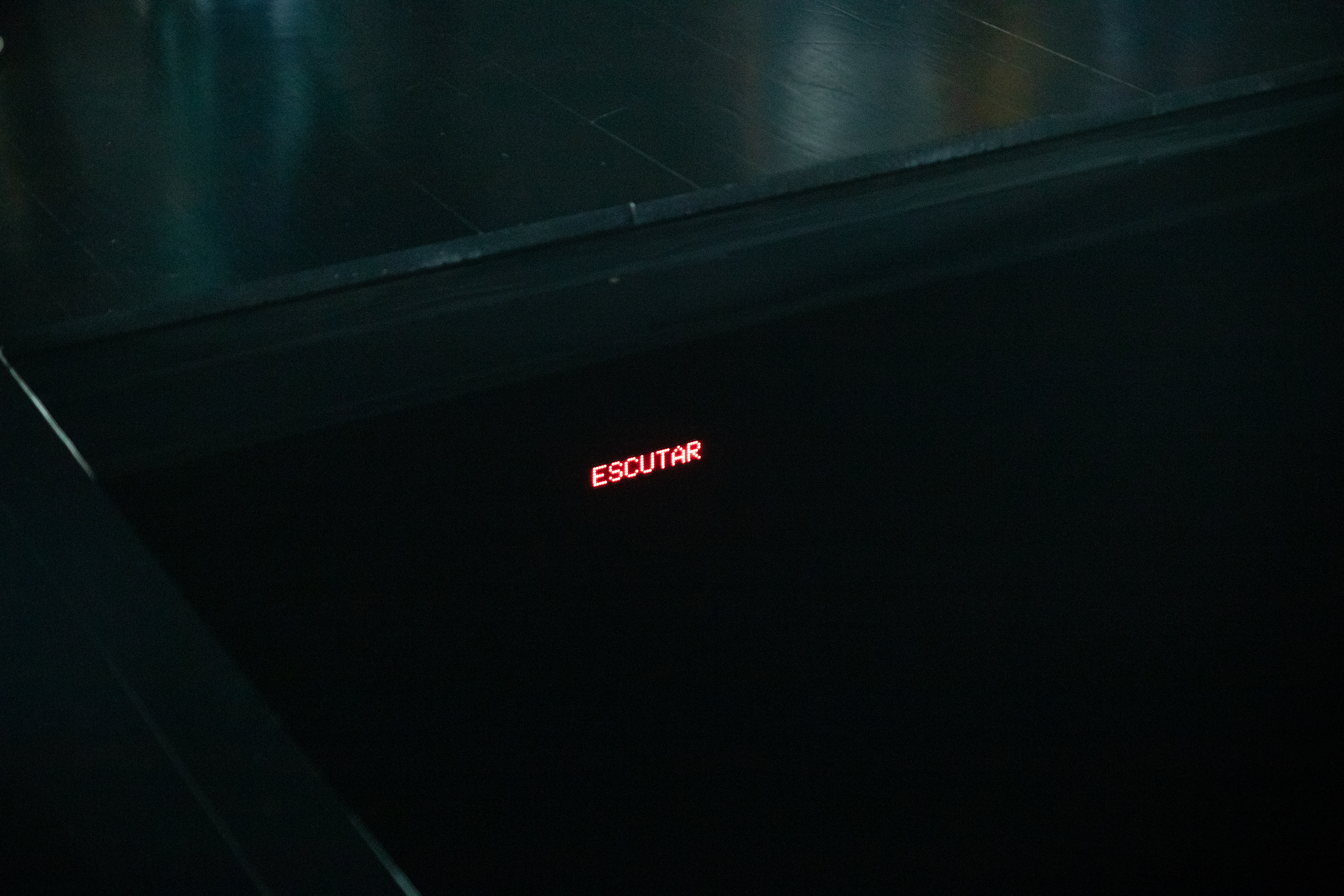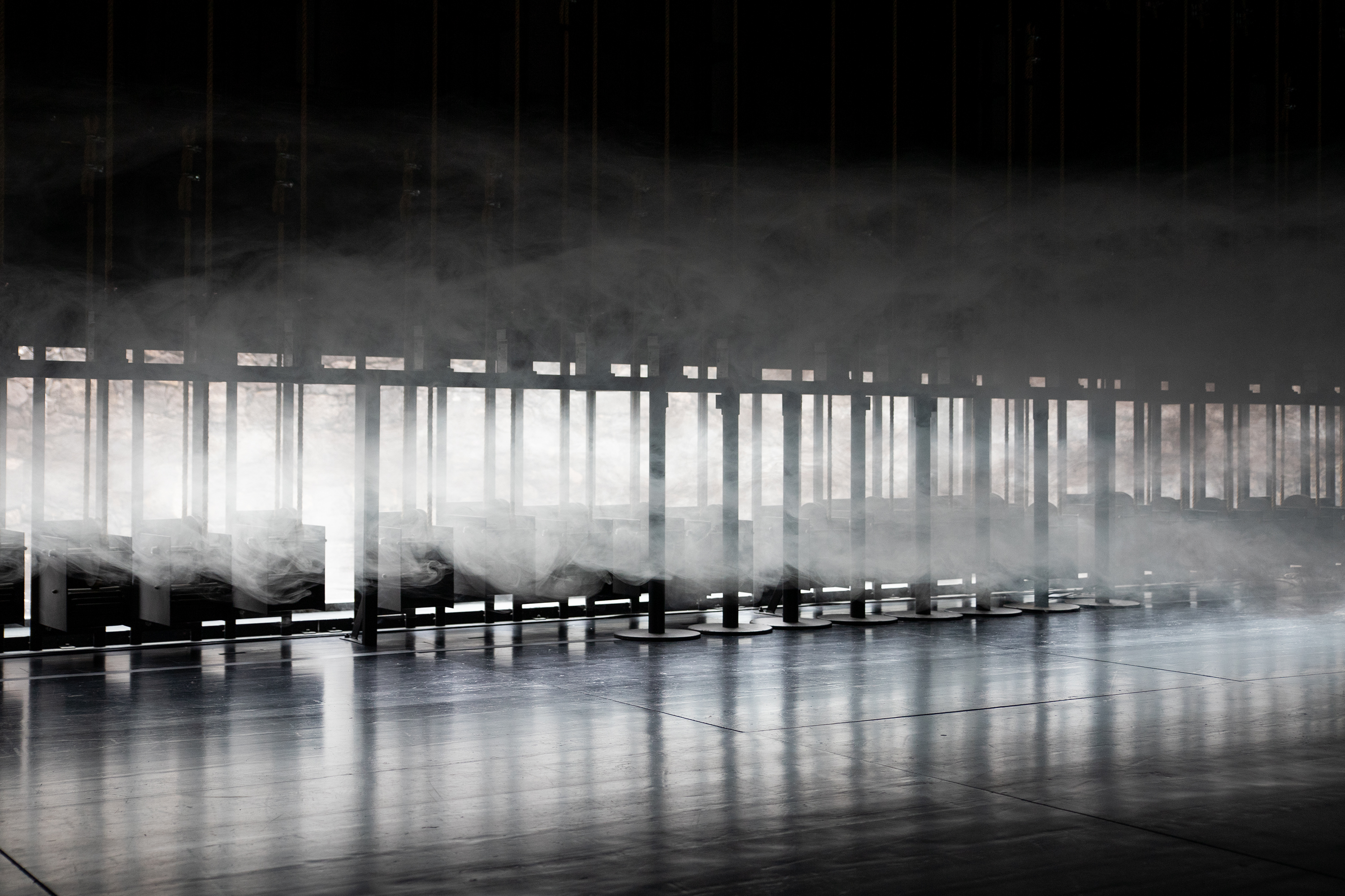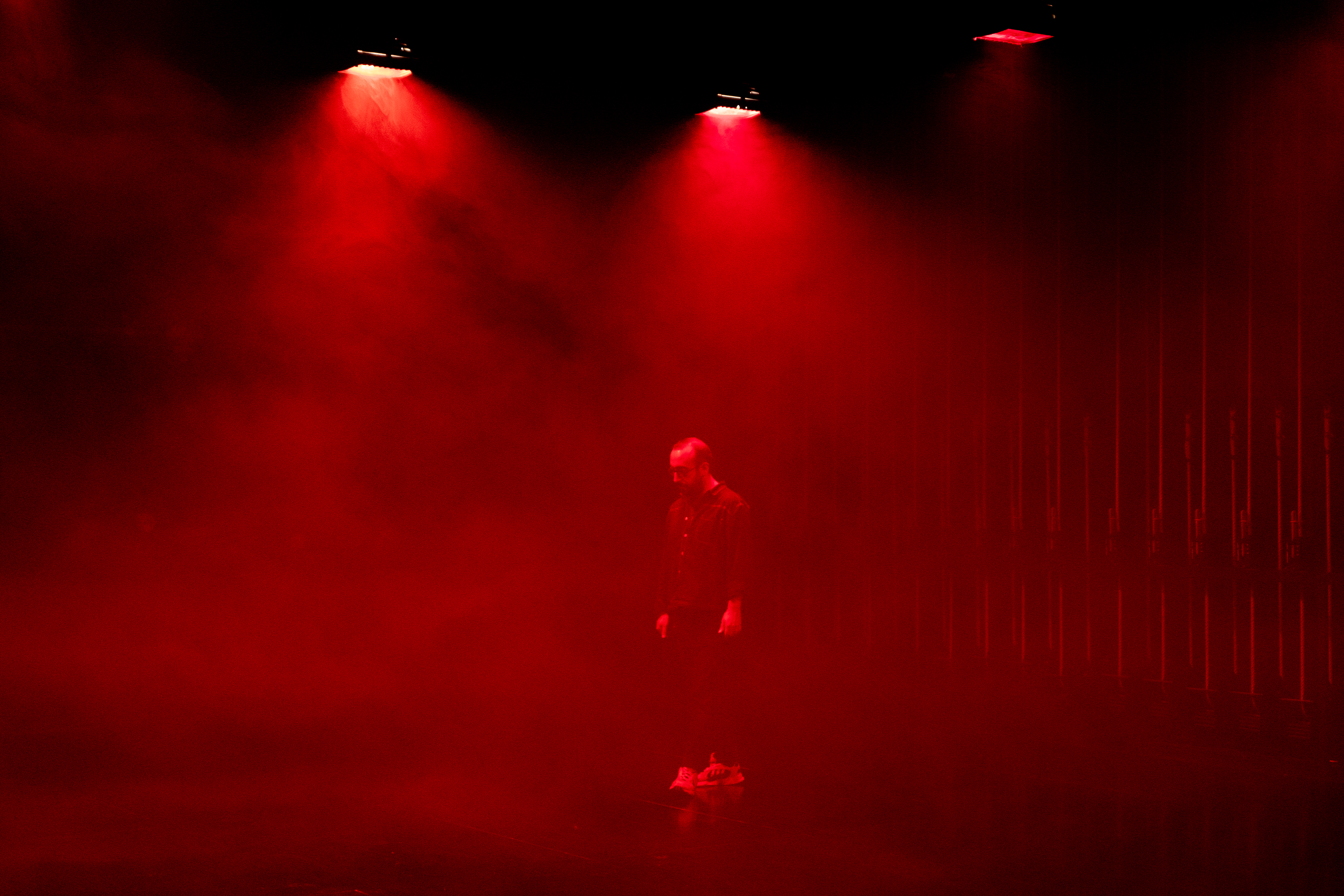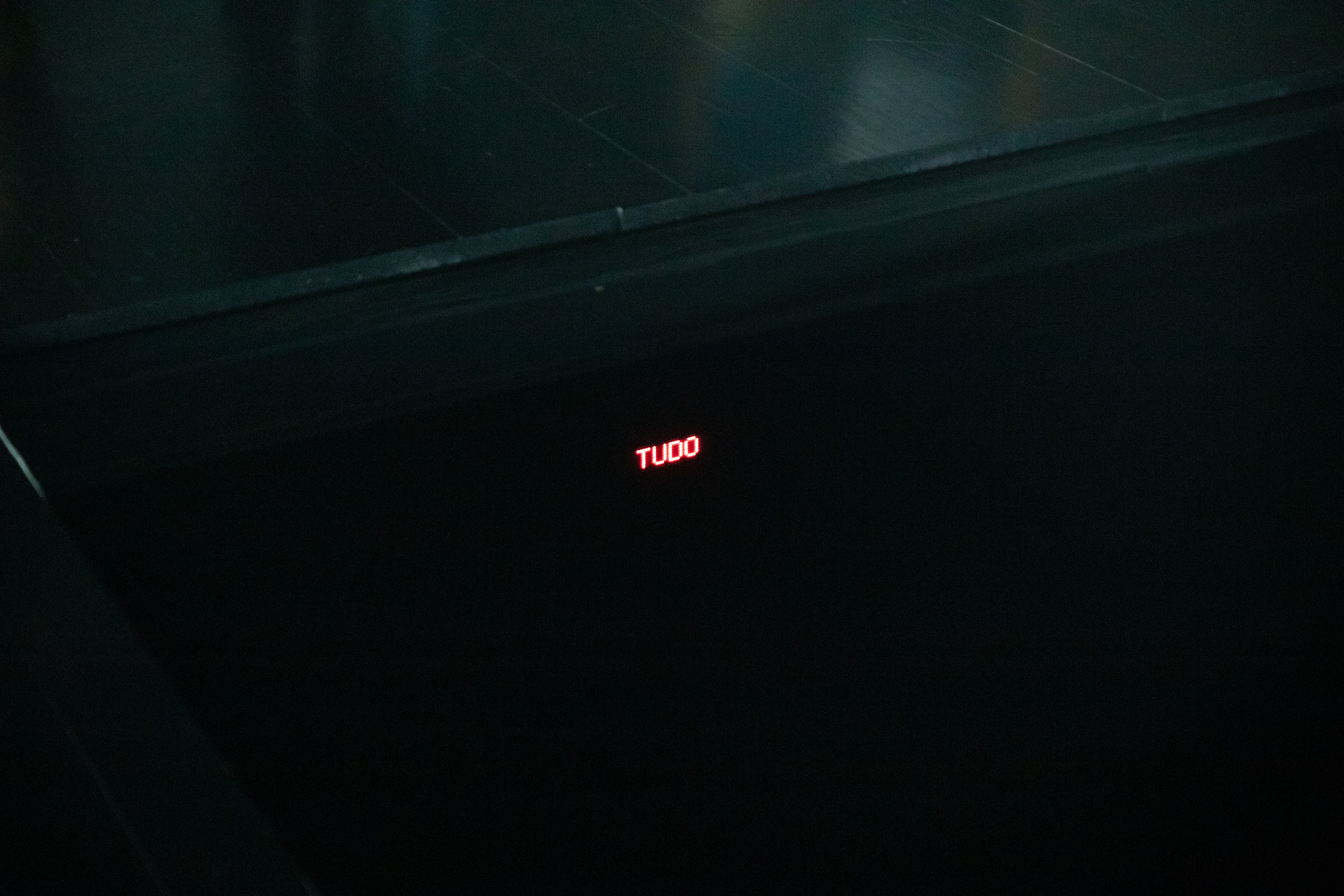[𝖋𝖎𝖓𝖎𝖘ˈ𝖙ɛ𝖗𝖗𝖆]
PRACTICES AND THEORIES FOR AN END OF THE WORLD
ongoing research
[𝖋𝖎𝖓𝖎𝖘ˈ𝖙ɛ𝖗𝖗𝖆] is the mythology of a place that evokes the end of the world. It's also the name I give to this research, which uses listening as a technology to imagine what exists beyond that end.
Believing in a future of inclusive narratives, where the human does not occupy the central narrative, and through a speculative, collaborative and interdisciplinary approach, this artistic research project summons practices and theories to enunciate a possible "future of the future".
This is a research and artistic creation project undertaken within Expanded Performing Arts to confront or accelerate the ‘end of this world’ (Krenak, Ferreira da Silva). Assuming that we are already living in the ‘urgency of the end’ (T.J. Demos) and that we are already ‘out of time’ (Karen Barad), the research elaborates on what will come next.
In the age of climate change and human decline, there is an urgent need to collectively imagine and create the conditions that make possible to co-inhabit the future in other ways.
What survival strategies do we need in this era of climate catastrophe? What conditions can we generate in order to regenerate our imaginations of the futures to come?
Through a speculative approach, this project has been exploring various practical and theoretical strategies aimed at imagining ways of surviving the present and building the future.
[𝖋𝖎𝖓𝖎𝖘ˈ𝖙ɛ𝖗𝖗𝖆] regularly mobilises a study group - Exploratory Group of Sound Practices - to investigate how aural, invisible and impalpable places and practices can contribute to recovering the means of imagining and producing common becomings.
Artistic Direction, Research and Performance
Sara Vieira Marques
'Exploratory Group for Sound Practice' study group
João Grilo; Ángela Díaz Quintela; Inês Luzio; Santiago Tricot; Irina Pereira
Grant for Artistic Research “Reclamar Tempo 2024” CAMPUS Paulo Cunha e Silva
Institutional SupportCAMPUS Paulo Cunha e Silva / TMP (Porto-PT); Artists’Shelter - Sekoia (Porto-PT); ApalleirA (Sarria-ES); Gnration - Braga Media Arts (Braga-PT); Binaural Nodar (Vouzela-PT); O Espaço do Tempo (Montemor-o-Novo-PT); mala voadora (Porto-PT); INAE - Instituto Nacional de Arte Escénicas (Montevideo-UY); NAVE Centro de Creación y Residencia (Santiago-CH);Parque Cultural de Valparaíso (Valparaíso-CH)
*this project was awarded: RECLAMAR TEMPO Artistic Research Grant 2024 - Campus Paulo Cunha e Silva (PT)

2024 / 2026
UNDOING LISTENING
[𝖋𝖎𝖓𝖎𝖘ˈ𝖙ɛ𝖗𝖗𝖆] project
UNDOING LISTENING is the first performative practice that emerges from the research project [𝖋𝖎𝖓𝖎𝖘ˈ𝖙ɛ𝖗𝖗𝖆]. It is an installation-performance that seeks to “undo” and systematize listening in order to expand its possibilities. Undoing listening.
UNDOING - REVERSING - DISORGANIZING - DESTROYING - SHATTERING - OPENING UP - EXPLODING - DISPERSING - TRANSFORMING - VANISHING
Taking as its inspiration the theories and methodologies of composers Eliane Radigue and Pauline Oliveros, UNDOING LISTENING explores the performative, physical and conceptual dimensions of listening and acoustics, approaching them as tools and technologies for “futuring”. Listening is to be understood here as a radical and complex practice, a continuous, intentional and active action of the auditory functions, but also as a state of deep attention, which involves not only listening, but also seeing, beholding, moving, meditating and imagining.
Artistic Direction, Choreography and Performance
Sara Vieira Marques
Light Design and Collaboration
Santiago Rodriguez Tricot
Artistic Assistance
Nuno Preto, Inês Luzio e Ángela Diaz Quintela
Sound Adviser
João Bento
Instalation and Object concept and design
Sara Vieira Marques
Object construction
Pedro Guimarães (final version), Carlos Neves (prototype)
Co-production
‘Artistas Douro’ by mala voadora, with funding from CMPorto
Artistic Reasearch Support
‘Reclamar Tempo 2024’ CAMPUS Paulo Cunha e Silva
Residencies
fAUNA - Teatro da Didascália (Joane-PT); Artists' Shelter - Sekoia (Porto-PT); ApalleirA (Sarria-ES); Gnration (Braga-PT); mala voadora (Porto-PT); CRL - Central Eléctrica (Porto-PT); Binaural Nodar (Vouzela-PT); O Espaço do Tempo (Montemor-o-Novo-PT); INAE - Instituto Nacional de artes Escénicas (Montevideo-UY).
Acknowledgements
Diaz Quintela family; Santos; João Grilo; Irina Pereira; Cristina Planas Leitão; Lígia Andrade; Fabrizio Rossi; Bianca Garibaldi; Vera Garat; Santiago Turenne; Florencia Lindner; Florencia Martinelli and Bruno Brandolino. To Nuno, Inês, Ángela and Santi for always giving everything without asking for anything back.
----
Presentations- INAE Instituto Nacional de Artes Escénicas (december 2024) *preview
- mala voadora (january 2025) *premier
- Binaural Nodar (april 2025)
- FIDCU Festival Internacional de Danza Contemporánea de Ururguay (september 2025)
*this project was awarded: ARTISTAS DOURO Artistic Grant 2024 - mala voadora (PT); ARTIST’SHELTER Residency Support- Sekoia (PT); fAUNA Residency Support - T.Didascália (PT)
©SantiagoTricot
mala voadora, Porto
january 2025
january 2025
RESONATING ISLANDS
A SONOROUS ARCHIPELAGO
RESONATING ISLANDS_A SONOROUS ARCHIPELAGO is an artistic research project that starts from a questioning about the material and ecological experience of the human body when confronted with its natural and phenomenological environments.
Departing from the physical study of geological and atmospheric phenomena and the imagination of common futures, this project activates the materialisation of non-anthropocentric performative places.
Blurring the boundaries between the performing and visual arts, this research puts into practice "imaginary geographies": mountains, which are islands, which are volcanoes, which are the centre of the earth, which are the beginning.
RESONATING ISLANDS proposes a set of scenarios in the performative space that produce abstract places where the human does not occupy the central figure nor the central narrative. Prioritising the work of light, sound and space - languages that use non-human materials and work with their "invisibility" - the project comes to pay real attention, not only to the relationships between human bodies and their presence, but also between everything that belongs to our relational systems.
In 2023 this project was premiered in Arquipélago Contemporary Arts Center (Azores, Portugal) as a Listening Session, a performance where a light, sound and spatial installation was responding in real time to seismic data from the Azores archipelago, positioned over a triple tectonic junction of constant activity.
Artistic Direction, Choreography and Research
Sara Vieira Marques & Santiago Rodriguez Tricot
Artistic Assistance
Romain Teule
Light and Space Installation Sara Vieira Marques and Santiago Rodriguez Tricot
Sound Design and Collaboration
Fabrizio Rossi
Production
Carol Goulart
Co-production
Anda&Fala
Grant - Finatial Support
Calouste Gulbenkian Foundation
ResidenciesForum Dança (Lisbon - PT); Devir Capa (Faro - PT); CAMPUS Paulo Cunha e Silva (Porto-PT); vaga - espaço de arte e conhecimento (Azores -PT); CRL - Central Eléctrica (Porto-PT); Arquipélago Contemporary Arts Center (Azores -PT); TMP - Teatro Municipal do Porto (Porto-PT); NAVE - Centro de Creación y Residencia (Chile); Parque Cultural de Valparaíso (Chile); Mansa Mansion (Argentina), Universidade de Córdoba (Argentina)
*this project was awarded the Artistic Creation Grant 22/23 - Calouste Gulbenkian Foundation(PT)
AURORA
AURORA is a performance in which I use my body as part of a feedback system and where I explore for the first time the relationship between space and sound in order to address and confront the theories of the Anthropocene and deep time.
It emerges from a research on the methodologies developed by the french composer Eliane Radigue on her Feedback Works (1969-1970), spetially what she latter called “feedback of reinjection”.
Dealing with feedback as a relational and material system, this performance poses some ontological questions about the relationships between bodies and their spaces and materialities.
AURORA started from a practice of diary writing as a record and cartography of this questioning. Over time, it became a practice of listening to the subjective dimensions of sound, geology, electronic and human bodies in order to make a series of practical speculations with them.
This project converges into a series of temporal sculptures within a sound installation, making use of the capture, production and reproduction of sound as physical material and language, to explore the relationships with geological, electromagnetic and human materials.
Choreography, Research and Performance
Sara Vieira Marques
Technical Consultancy
Santiago Rodriguez Tricot
Light and Sound Installation
Sara Vieira Marques
Production
Forum Dança
Photography and Video
Ana Mariz
Thanks to
Alkantara; João dos Santos Martins; Alina Ruiz Folini; Joana Sá; Adriana Sá; Daniel Pizamiglio; Gustavo Ciríaco; Ana Trincão.
Residencies
Forum Dança (Lisbon-PT), Rumo do Fumo (Lisbon-PT); Espaço do Tempo (Montemor-o-velho-PT), Fogo Lento: CAMPO (Vila Nova de Gaia-PT); Espaço Alkantara (Lisbon-PT); Penhasco (Lisbon-PT)
*this project was awarded by ESTRUME Artistic Grant 2021 - Fogo Lento Associação Cultural (PT)
OSSU
OSSU is an ethnographic diary of my relationship with a stone. It is a diary shared from a distance. The beginning of a research.
During the pandemic I raised many questions about materiality, temporality, the human condition and its vunerability towards non-human forces (like viruses, fungi, natural disasters, the internet...) This project is situated precisely within that circumstance, time and context.
Trying to understand the relations between human, phenomenological and geological bodies, but also in order to recover the mobility torpid by the pandemic - to be able to walk, to breathe, to sunbathe, to leave home - I travelled to the Azores, from where I brought back a set of volcanic stones, dark and porous, that I still keep with me today. When I returned to Lisbon I began to wonder why I had brought these stones with me. I thought: "these stones are a mountain, which in turn is an island, in the Atlantic. Why did I make them go through a suitcase, through an airport, a plane hold, make them ascend to an altitude of over 35,000 feet, and then descend them to a new continent, a new city and of course, finally, to my home?"
I thought it would be nice to do something with these rocks. But I had had enough of working alone, talking to myself, always in a closed circuit. I decided to invite the artist, researcher and musician Joana Sá, whom I barely knew, to keep one of the stones with her. I would keep the other.
At that date I couldn't imagine that this dialogue would make the invisible imaginary of sound flourish abundantly in me, with which I would develop a performance ("Aurora", 2020) and with which I would start a research journey on material ecologies and post-humanism, whose first ideas can be found in this text ("OSSU", 2020).
For some time Joana and I shared correspondence, and a kind of constant resonance gave rise to this text.
This text is therefore a diary but also a continued action, motion, movement. It is a performative diary of that resonance and that imaginary.
Concept, Writing an Research
Sara Vieira Marques
Resonance
Joana Sá
Editorial support
Rita Natálio
Publisher
Forum Dança
Forum Dança, Lisbon
may 2020
may 2020
*A version of this text was published in PEGADA (link for full publication- in portuguese), an independent publication that brought together written works by dance and performance artists about their practices. (This text is written in Portuguese and not published in English)










